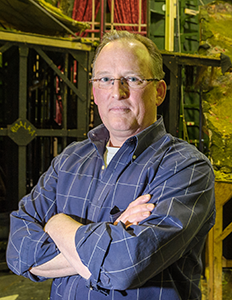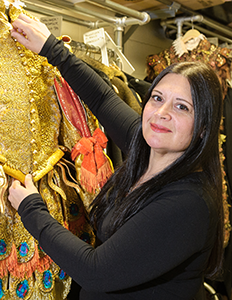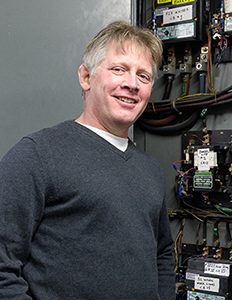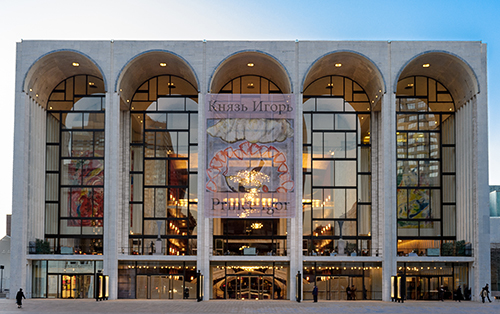Adelphi alumni Paul Donohue ‘88, Elise Aragon ’84, Eric Amundsen ’84 and Vinny Losito are all at The Metropolitan Opera.
For a growing number of Adelphi alumni, these are far from mere fantasies. They are encapsulations of how the network they created as students has fueled them as professionals—and how it continues to nurture today’s students.
by Bonnie Eissner
He was a professional ballet dancer until he realized that he preferred setting up scenery. She gave up her dream of acting to sew costumes. He knew he wanted to be a theatre technician in grade school and has pursued his dream in some surprising settings.
Life, like opera, has many acts (and a few intermissions). For Adelphi alumni Paul Donohue ‘88, Elise Aragon ’84 and Eric Amundsen ’84, a life in opera is their second (or maybe third) act. And they haven’t landed at any old opera company. They are at The Metropolitan Opera.
If The Met were a woman, she would be a diva—grand, famous, imbued with personality and talent. From its chandeliers—32 of them with 49,000 pieces of crystal—to its abundant red carpet—replaced annually—to its renowned acoustics, The Met embodies opulence and beauty. More than a mere theatre, it is the physical representation of the grand (some might say grandiose) art form it presents.
The Met creates magic for opera lovers by being meticulous, and working there involves talent and grit.

Paul Donohue ’88
“This is the Yankees; this isn’t double-A baseball,” says Mr. Donohue. He would know. He started at The Met in 1988 working part-time on the service crew—unloading scenery from trucks—and rose to become the head electrician.
He and his team of 100 or so were responsible for all the lighting—from the chandeliers to the spotlights—as well as sound for the productions. (Mr. Donohue points out that, true to its lore, The Met amplifies singers only for broadcast, not for the music you hear in the house.) For comparison, Mr. Donohue notes that “a Broadway show will have five or six guys” in the electrical department. “I had that on stage right every night.”
Mr. Donohue is clearly ambitious. Even now, as a rigger for the massive sets at The Met, he typically works two consecutive shifts a day, making his normal workday about 15 hours long. “It’s sort of a joke, but not really, that you’ve got to be able to stay up late and be pleasant about it,” he says.
He also attributes his work ethic to his experience in Adelphi’s theatre design and technology program, where under the tutelage of Randall (Randy) Kline ’77, the technical director of Adelphi’s theatre, he and his classmates were “trained to think and work like professional stagehands.” Mr. Donohue had, in fact, met Mr. Kline before coming to Adelphi.
By the time he was 18, Mr. Donohue had established a career as a modern ballet dancer, but, he says, “it just became obvious to me that I wasn’t that good.” To make extra money, he helped load, unload and construct sets for major performance companies, including the Paul Taylor Dance Company, for which Mr. Kline also worked. When Mr. Donohue decided to head to college for a degree in theatre tech, he realized that Adelphi “just was a good fit.”
Mr. Kline and others at Adelphi who were connected to the New York theatre scene cultivated a strong work ethic in their students. The faculty and administrators simulated on a much smaller scale the rigor required of putting on the biggest shows.
Mr. Donohue started working part-time on The Met service crew the summer after he graduated from Adelphi when an acquaintance casually invited him to help out. For Mr. Donohue, it was a welcome and life-changing opportunity. “I used to hear stories about The Met; I always wanted to work here,” he says.

Elise Aragon ’84
Connections and elbow grease also brought Elise Aragon to the Met 23 years ago. She was working in a New York City costume shop when a co-worker told her about an opening for an assistant draper at The Met. (Ms. Aragon explains that a draper is a pattern-maker, or the person who selects, cuts and oversees the sewing of fabric for costumes based on a designer’s vision.) Even though the position was a slight step down from what she was doing at the time, she decided to pursue it. One of her first assignments at The Met involved making about 80 unitards for an upcoming production. “Actually, one of the reasons that I think they hired me was because I had this background in making stretch things [at Adelphi],” Ms. Aragon recalls.
Why was she making so many stretch outfits at Adelphi? In short, because, as a theatre tech major, she created costumes for Adelphi’s dance as well as its theatre productions. With so many dancers to dress for a variety of productions, Ms. Aragon became well versed in creating outfits that were both theatrical and elastic. “I did a lot of sewing; I did a lot of patterning,” Ms. Aragon recalls.
For her first two years at Adelphi, Ms. Aragon was an acting major. “I actually thought I might want to be an actress and realized that there was much more opportunity for me in costumes,” she says. Like Mr. Donohue, she found an Adelphi mentor—the costume shop supervisor, Tracy Gray, who even helped Ms. Aragon land her first gigs in the New York City costume world. “She was a very big influence on me working at all,” Ms. Aragon says.
In a typical 33-week season, The Met will mount about 32 productions. That means that everyone is working at a furious pace. And, Ms. Aragon points out, standards are extremely high. The costumes she makes now as a draper must outlast an opera’s opening night and be just as stunning and functional years later.

Eric Amundsen ’84
When Eric Amundsen joined The Met as an electrician in 1993, he was part of the team that built the Met Titles—the tiny screens on the back of each seat that show translations of the lyrics. At the time, most opera companies were using supertitles—large screens suspended above the stage on which the translations would appear. Cognizant that a number of its patrons preferred their opera unadulterated by translations, The Met took a different approach. Mr. Amundsen describes building—in just one summer—4,000 LED screens that can be manually turned on and off and are polarized to protect audience members from viewing their neighbors’ screens. Nearly 20 years later, the system is still in place, and, Mr. Amundsen notes, it “has helped make an audience more engaged with the actors.”
Mr. Amundsen knew in grammar school that he wanted to be in theatre tech. “I remember we were doing the Wizard of Oz and they needed a fire effect for the witch,” he recalls. “I made something out of plastic and shined a light on it and it popped up and the audience went ‘ooh,’ and I was like, ‘wow, that’s cool.’ And I’ve been doing it ever since.”
As a theatre major Adelphi, Mr. Amundsen was supported by the Barnes Scholarship. He echoes Mr. Donohue and Ms. Aragon in praising the expertise of the Adelphi faculty and the hands-on nature of the program. He recalls designing the set and lighting for everything from cabarets in The Rathskeller to the spring dance performance. “It was a very creative time,” he says. “It was a lot of fun—a lot of all-nighters.”
In the decade between graduating from Adelphi and starting at The Met, Mr. Amundsen gained vast and varied experience. Right after Adelphi, while working at a stage scenery shop on New York’s Lower East Side, he helped build MTV’s first studio set. He was subsequently recruited by his former Adelphi professor, Allen Cornell, to serve as the technical director of the Riverside Theatre in Vero Beach, Florida. From there, he made his way to Orlando and eventually worked for Nickelodeon, building sets for game shows, including “Super Sloppy Double Dare” and “What Would You Do?”
Working at The Met has been his longest gig, and he appreciates the theatre’s rich history and commitment to innovation. Among Mr. Amundsen’s latest projects is helping The Met replace the more than 100 elevator motors that move its giant backdrops. Once cutting-edge, the motors are ill-equipped to move scenery either very quickly or very slowly. The trick for Mr. Amundsen and the team he’s on is to lay in a new system of motors while keeping the current one operational. “It couldn’t be the sort of thing where you shut down The Met for a year and rip everything out,” he says.

The Metropolitan Opera
For further information, please contact:
Todd Wilson
Strategic Communications Director
p – 516.237.8634
e – twilson@adelphi.edu